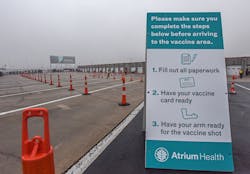As cities and states across the country work to distribute their allotments of Covid-19 vaccines as quickly and efficiently as possible, many locales have opted to host mass vaccination events at large venues to process the most residents in the shortest amount of time. But the benefits these facilities offer in terms of being able to accommodate more people while still adhering to social distancing policies also present unique challenges, such as bottlenecks at various checkpoints as people wait their turn to be inoculated.
Two recently held vaccination events in Charlotte – one at Charlotte Motor Speedway and the other at Bank of America Stadium, home of the NFL’s Carolina Panthers – demonstrate how today’s security solutions can be leveraged to address these concerns and help make the lives of local officials and healthcare workers a bit easier during these uncertain times.
Kinnera Angadi, Chief Technology Officer of Commercial Security at Honeywell Building Technologies, whose Pro-Watch Intelligent Command system was used to monitor vaccine operations at these venues, says that other divisions within Honeywell had already started working on implementing handheld devices at the sites to scan boxes of vaccine doses as they arrived and to aid technicians and patients in the registration process. However, Angadi knew that the company’s security technologies, particularly video surveillance and security management platforms, could be leveraged to improve vaccine distribution even further.
“Across Honeywell, multiple teams came together to look at how can we help during this massive pandemic and also administer these vaccines in a timely fashion,” Angadi says. “We jumped in and we were like, ‘can we use our cameras and artificial intelligence technology to help any of these processes?’”
Two Events – One Platform
For starters, Angadi says they examined what a typical day at one of these large-scale vaccination sites looked like and there were a couple of different scenarios that they had to address. At the speedway, for example, since people were going to drive in, they needed a way to identify people who had pre-registered as well as monitor people coming in, wait times, etc.
“We thought great. Let’s go assess the lay of the land, look at all of cameras that are already in place and how we can intelligently plug in through the AI and technology behind the scenes to count the cars and create a dashboard through Pro-Watch,” Angadi adds. “Then we said, ‘ok, we already have the platform, we already have some of the cameras deployed there, but we needed to identify the whole workflow. Think of it like the cars are coming in on the day from the entry all the way to exit with various checkpoints and there could be various optimizations in operations and efficiencies in terms of queuing and wait time.”
To accomplish this, the Honeywell team had to take the existing security infrastructure and combine it with some new solutions deployed specifically for the event, which was then integrated into a common operating picture.
“Once we had the infrastructure there, we had to make sure our cameras were deployed in a strategic way so we could use different zones and angles rather than duplicating all this infrastructure… and now we wanted to surface this data onto the platform,” Angadi explains. “It was all set up and we had the dashboard with these main analytics that we needed for that day, which was average wait time for a car from entry to the exit between each of the lanes and it was published through the partnership on the Atrium Health side. As people were registering you would have that information."
As cars flowed though the speedway over the weekend – about 16,00 to 17,000 in all – Angadi says they were able to look at the optimizations and they realized that some significant time savings had been achieved.
The other scenario that they had to plan for was at Bank of America Stadium where people would be coming in on foot rather than in vehicles, which changed the variables somewhat. Although it was harder to predict wait times with foot traffic while simultaneously ensuring that all protocols were followed to protect personally identifiable information (PII), Angadi says they were still able to manage the flow of people with data similar to how they had handled cars at the speedway and place it on the dashboard. In all, some 20,000 people were inoculated at the stadium during the event.
A Roadmap for the Future
Angadi hopes that they can take the lessons learned from the mass vaccination events in Charlotte and replicate it at venues across the country.
“When you look at technology and how we have helped this massive operation… to be fair the real challenge was on improving the operations and efficiencies and when we deploy technologies to help and assist the operations happening on the site, I don’t necessarily see us like, ‘oh, we could have done this and that,’ but what I can say is we can take the learnings from here combined with a playbook-type of thing that we can expand beyond these locations,” she says. “Technology can be leveraged – this end-to-end operation that we have – starting with the (vaccine) batch scanner and vaccines left on the site and the counting of cars and people flowing through and this could be advanced to a playbook to take it further to different counties and states.”
Joel Griffin is the Editor-in-Chief of SecurityInfoWatch.com and a veteran security journalist. You can reach him at [email protected].

